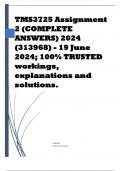Exam (elaborations)
TMS3725 Assignment 2 (COMPLETE ANSWERS) 2024 (313968) - 19 June 2024 Course Teaching Mathematics in Further Education and Trai (TMS3725) Institution University Of South Africa (Unisa) Book Teaching Mathematics
- Course
- Institution
- Book
TMS3725 Assignment 2 (COMPLETE ANSWERS) 2024 (313968) - 19 June 2024 Course Teaching Mathematics in Further Education and Trai (TMS3725) Institution University Of South Africa (Unisa) Book Teaching Mathematics
[Show more]



